British Raj in India: Paradoxes, Hypocrisy, and Social Changes Essay
VerifiedAdded on 2023/05/28
|6
|1927
|262
Essay
AI Summary
This essay delves into the complexities of the British Raj in India, highlighting the paradoxes of progress and oppression, the hypocrisy evident in social interactions, and the significant social changes that occurred during this period. It explores the dichotomy of glamour and brutality, the elitism of British clubs excluding most Indians, and the exploitation of Indian women. The essay also discusses the introduction of the printing press and the rise of Indian-owned newspapers, showcasing both the control exerted by the British and the emergence of Indian voices. Furthermore, it touches upon the segregation of Indian society, the role of loyalists and revolutionaries, and the improvements in the status of Indian women through education and social reform. The document is available on Desklib, a platform offering various AI-based study tools and resources for students.

Running head : HISTORY ESSAY
HISTORY ESSAY
Name of the Student:
Name of the University:
Author Note:
HISTORY ESSAY
Name of the Student:
Name of the University:
Author Note:
Paraphrase This Document
Need a fresh take? Get an instant paraphrase of this document with our AI Paraphraser
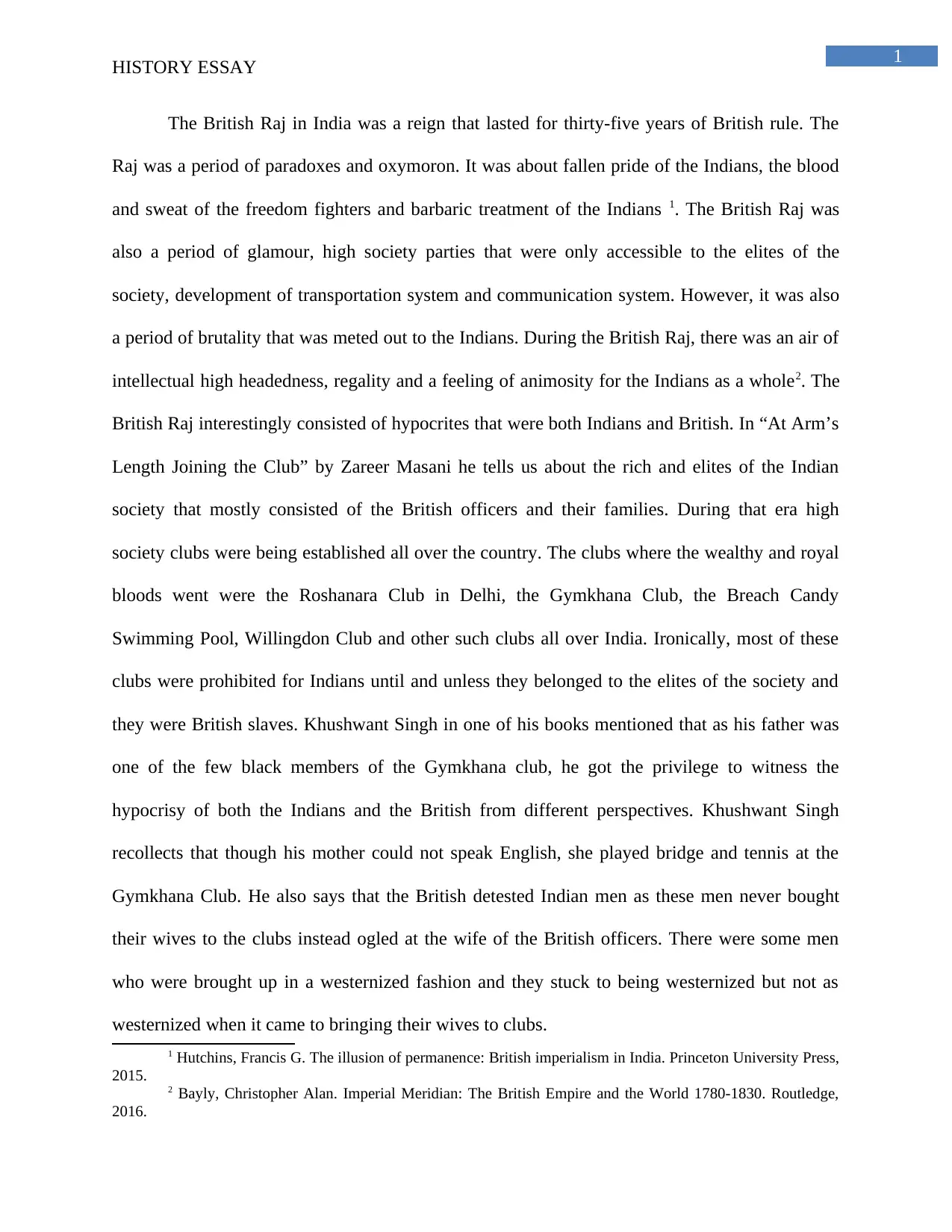
1
HISTORY ESSAY
The British Raj in India was a reign that lasted for thirty-five years of British rule. The
Raj was a period of paradoxes and oxymoron. It was about fallen pride of the Indians, the blood
and sweat of the freedom fighters and barbaric treatment of the Indians 1. The British Raj was
also a period of glamour, high society parties that were only accessible to the elites of the
society, development of transportation system and communication system. However, it was also
a period of brutality that was meted out to the Indians. During the British Raj, there was an air of
intellectual high headedness, regality and a feeling of animosity for the Indians as a whole2. The
British Raj interestingly consisted of hypocrites that were both Indians and British. In “At Arm’s
Length Joining the Club” by Zareer Masani he tells us about the rich and elites of the Indian
society that mostly consisted of the British officers and their families. During that era high
society clubs were being established all over the country. The clubs where the wealthy and royal
bloods went were the Roshanara Club in Delhi, the Gymkhana Club, the Breach Candy
Swimming Pool, Willingdon Club and other such clubs all over India. Ironically, most of these
clubs were prohibited for Indians until and unless they belonged to the elites of the society and
they were British slaves. Khushwant Singh in one of his books mentioned that as his father was
one of the few black members of the Gymkhana club, he got the privilege to witness the
hypocrisy of both the Indians and the British from different perspectives. Khushwant Singh
recollects that though his mother could not speak English, she played bridge and tennis at the
Gymkhana Club. He also says that the British detested Indian men as these men never bought
their wives to the clubs instead ogled at the wife of the British officers. There were some men
who were brought up in a westernized fashion and they stuck to being westernized but not as
westernized when it came to bringing their wives to clubs.
1 Hutchins, Francis G. The illusion of permanence: British imperialism in India. Princeton University Press,
2015. 2 Bayly, Christopher Alan. Imperial Meridian: The British Empire and the World 1780-1830. Routledge,
2016.
HISTORY ESSAY
The British Raj in India was a reign that lasted for thirty-five years of British rule. The
Raj was a period of paradoxes and oxymoron. It was about fallen pride of the Indians, the blood
and sweat of the freedom fighters and barbaric treatment of the Indians 1. The British Raj was
also a period of glamour, high society parties that were only accessible to the elites of the
society, development of transportation system and communication system. However, it was also
a period of brutality that was meted out to the Indians. During the British Raj, there was an air of
intellectual high headedness, regality and a feeling of animosity for the Indians as a whole2. The
British Raj interestingly consisted of hypocrites that were both Indians and British. In “At Arm’s
Length Joining the Club” by Zareer Masani he tells us about the rich and elites of the Indian
society that mostly consisted of the British officers and their families. During that era high
society clubs were being established all over the country. The clubs where the wealthy and royal
bloods went were the Roshanara Club in Delhi, the Gymkhana Club, the Breach Candy
Swimming Pool, Willingdon Club and other such clubs all over India. Ironically, most of these
clubs were prohibited for Indians until and unless they belonged to the elites of the society and
they were British slaves. Khushwant Singh in one of his books mentioned that as his father was
one of the few black members of the Gymkhana club, he got the privilege to witness the
hypocrisy of both the Indians and the British from different perspectives. Khushwant Singh
recollects that though his mother could not speak English, she played bridge and tennis at the
Gymkhana Club. He also says that the British detested Indian men as these men never bought
their wives to the clubs instead ogled at the wife of the British officers. There were some men
who were brought up in a westernized fashion and they stuck to being westernized but not as
westernized when it came to bringing their wives to clubs.
1 Hutchins, Francis G. The illusion of permanence: British imperialism in India. Princeton University Press,
2015. 2 Bayly, Christopher Alan. Imperial Meridian: The British Empire and the World 1780-1830. Routledge,
2016.
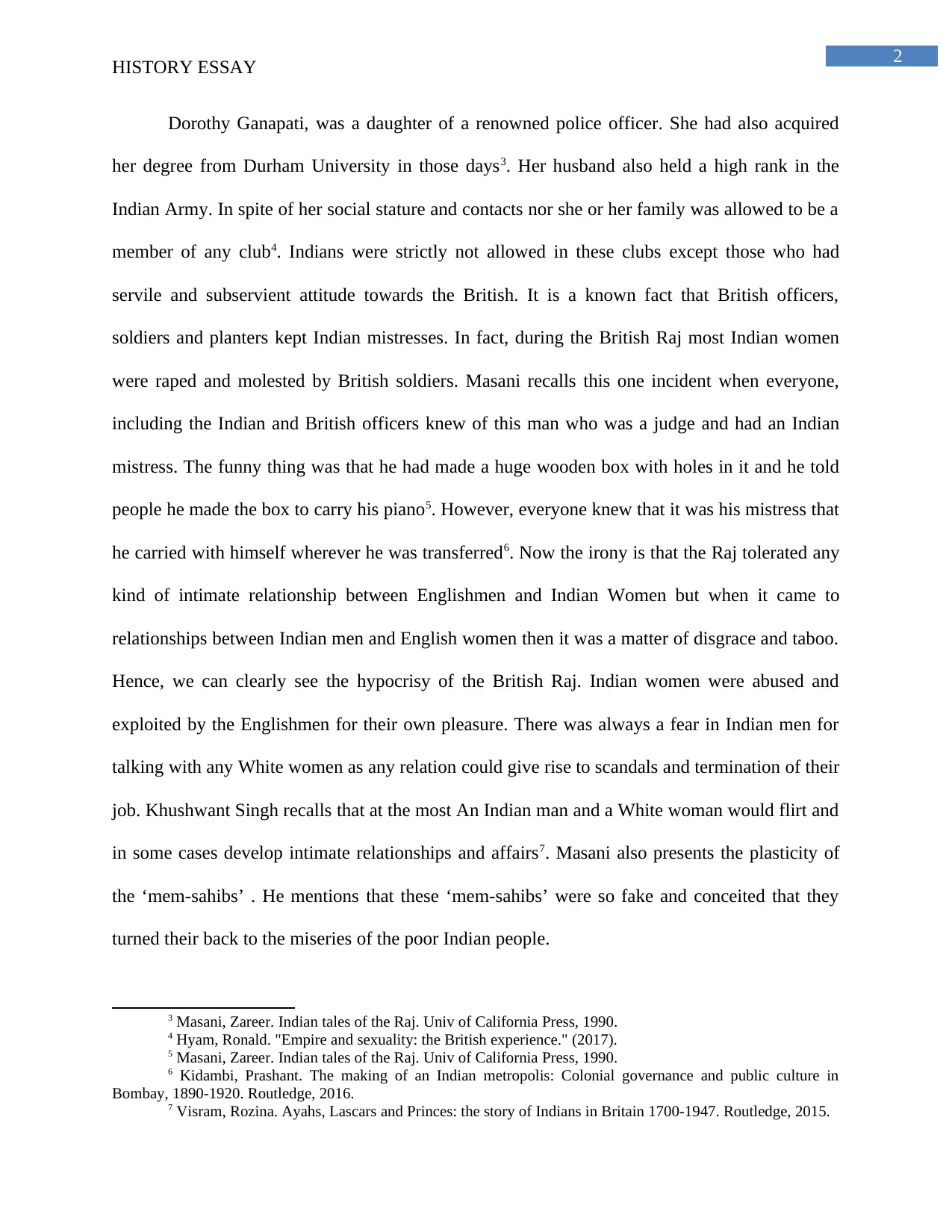
2
HISTORY ESSAY
Dorothy Ganapati, was a daughter of a renowned police officer. She had also acquired
her degree from Durham University in those days3. Her husband also held a high rank in the
Indian Army. In spite of her social stature and contacts nor she or her family was allowed to be a
member of any club4. Indians were strictly not allowed in these clubs except those who had
servile and subservient attitude towards the British. It is a known fact that British officers,
soldiers and planters kept Indian mistresses. In fact, during the British Raj most Indian women
were raped and molested by British soldiers. Masani recalls this one incident when everyone,
including the Indian and British officers knew of this man who was a judge and had an Indian
mistress. The funny thing was that he had made a huge wooden box with holes in it and he told
people he made the box to carry his piano5. However, everyone knew that it was his mistress that
he carried with himself wherever he was transferred6. Now the irony is that the Raj tolerated any
kind of intimate relationship between Englishmen and Indian Women but when it came to
relationships between Indian men and English women then it was a matter of disgrace and taboo.
Hence, we can clearly see the hypocrisy of the British Raj. Indian women were abused and
exploited by the Englishmen for their own pleasure. There was always a fear in Indian men for
talking with any White women as any relation could give rise to scandals and termination of their
job. Khushwant Singh recalls that at the most An Indian man and a White woman would flirt and
in some cases develop intimate relationships and affairs7. Masani also presents the plasticity of
the ‘mem-sahibs’ . He mentions that these ‘mem-sahibs’ were so fake and conceited that they
turned their back to the miseries of the poor Indian people.
3 Masani, Zareer. Indian tales of the Raj. Univ of California Press, 1990.
4 Hyam, Ronald. "Empire and sexuality: the British experience." (2017).
5 Masani, Zareer. Indian tales of the Raj. Univ of California Press, 1990.
6 Kidambi, Prashant. The making of an Indian metropolis: Colonial governance and public culture in
Bombay, 1890-1920. Routledge, 2016.
7 Visram, Rozina. Ayahs, Lascars and Princes: the story of Indians in Britain 1700-1947. Routledge, 2015.
HISTORY ESSAY
Dorothy Ganapati, was a daughter of a renowned police officer. She had also acquired
her degree from Durham University in those days3. Her husband also held a high rank in the
Indian Army. In spite of her social stature and contacts nor she or her family was allowed to be a
member of any club4. Indians were strictly not allowed in these clubs except those who had
servile and subservient attitude towards the British. It is a known fact that British officers,
soldiers and planters kept Indian mistresses. In fact, during the British Raj most Indian women
were raped and molested by British soldiers. Masani recalls this one incident when everyone,
including the Indian and British officers knew of this man who was a judge and had an Indian
mistress. The funny thing was that he had made a huge wooden box with holes in it and he told
people he made the box to carry his piano5. However, everyone knew that it was his mistress that
he carried with himself wherever he was transferred6. Now the irony is that the Raj tolerated any
kind of intimate relationship between Englishmen and Indian Women but when it came to
relationships between Indian men and English women then it was a matter of disgrace and taboo.
Hence, we can clearly see the hypocrisy of the British Raj. Indian women were abused and
exploited by the Englishmen for their own pleasure. There was always a fear in Indian men for
talking with any White women as any relation could give rise to scandals and termination of their
job. Khushwant Singh recalls that at the most An Indian man and a White woman would flirt and
in some cases develop intimate relationships and affairs7. Masani also presents the plasticity of
the ‘mem-sahibs’ . He mentions that these ‘mem-sahibs’ were so fake and conceited that they
turned their back to the miseries of the poor Indian people.
3 Masani, Zareer. Indian tales of the Raj. Univ of California Press, 1990.
4 Hyam, Ronald. "Empire and sexuality: the British experience." (2017).
5 Masani, Zareer. Indian tales of the Raj. Univ of California Press, 1990.
6 Kidambi, Prashant. The making of an Indian metropolis: Colonial governance and public culture in
Bombay, 1890-1920. Routledge, 2016.
7 Visram, Rozina. Ayahs, Lascars and Princes: the story of Indians in Britain 1700-1947. Routledge, 2015.
⊘ This is a preview!⊘
Do you want full access?
Subscribe today to unlock all pages.

Trusted by 1+ million students worldwide
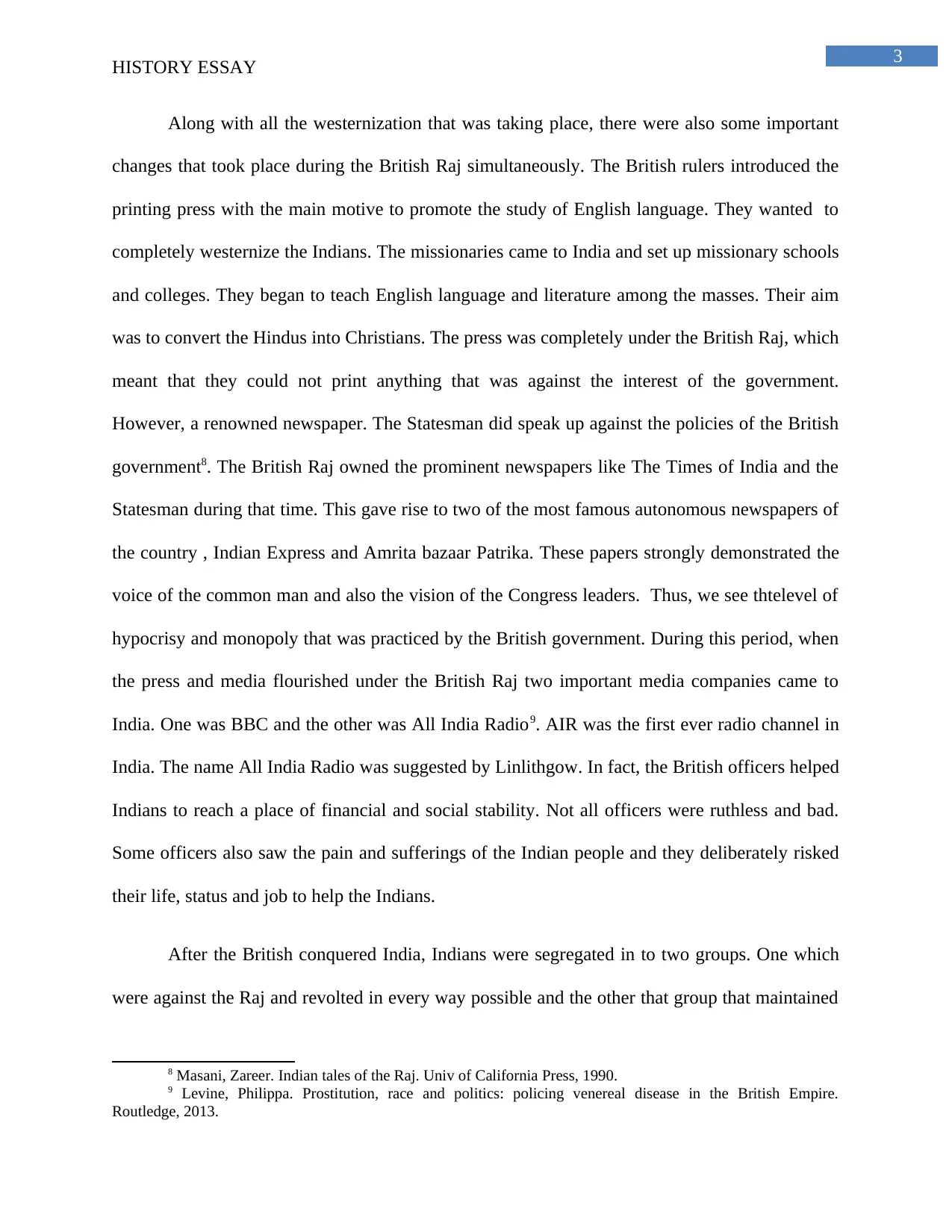
3
HISTORY ESSAY
Along with all the westernization that was taking place, there were also some important
changes that took place during the British Raj simultaneously. The British rulers introduced the
printing press with the main motive to promote the study of English language. They wanted to
completely westernize the Indians. The missionaries came to India and set up missionary schools
and colleges. They began to teach English language and literature among the masses. Their aim
was to convert the Hindus into Christians. The press was completely under the British Raj, which
meant that they could not print anything that was against the interest of the government.
However, a renowned newspaper. The Statesman did speak up against the policies of the British
government8. The British Raj owned the prominent newspapers like The Times of India and the
Statesman during that time. This gave rise to two of the most famous autonomous newspapers of
the country , Indian Express and Amrita bazaar Patrika. These papers strongly demonstrated the
voice of the common man and also the vision of the Congress leaders. Thus, we see thtelevel of
hypocrisy and monopoly that was practiced by the British government. During this period, when
the press and media flourished under the British Raj two important media companies came to
India. One was BBC and the other was All India Radio9. AIR was the first ever radio channel in
India. The name All India Radio was suggested by Linlithgow. In fact, the British officers helped
Indians to reach a place of financial and social stability. Not all officers were ruthless and bad.
Some officers also saw the pain and sufferings of the Indian people and they deliberately risked
their life, status and job to help the Indians.
After the British conquered India, Indians were segregated in to two groups. One which
were against the Raj and revolted in every way possible and the other that group that maintained
8 Masani, Zareer. Indian tales of the Raj. Univ of California Press, 1990.
9 Levine, Philippa. Prostitution, race and politics: policing venereal disease in the British Empire.
Routledge, 2013.
HISTORY ESSAY
Along with all the westernization that was taking place, there were also some important
changes that took place during the British Raj simultaneously. The British rulers introduced the
printing press with the main motive to promote the study of English language. They wanted to
completely westernize the Indians. The missionaries came to India and set up missionary schools
and colleges. They began to teach English language and literature among the masses. Their aim
was to convert the Hindus into Christians. The press was completely under the British Raj, which
meant that they could not print anything that was against the interest of the government.
However, a renowned newspaper. The Statesman did speak up against the policies of the British
government8. The British Raj owned the prominent newspapers like The Times of India and the
Statesman during that time. This gave rise to two of the most famous autonomous newspapers of
the country , Indian Express and Amrita bazaar Patrika. These papers strongly demonstrated the
voice of the common man and also the vision of the Congress leaders. Thus, we see thtelevel of
hypocrisy and monopoly that was practiced by the British government. During this period, when
the press and media flourished under the British Raj two important media companies came to
India. One was BBC and the other was All India Radio9. AIR was the first ever radio channel in
India. The name All India Radio was suggested by Linlithgow. In fact, the British officers helped
Indians to reach a place of financial and social stability. Not all officers were ruthless and bad.
Some officers also saw the pain and sufferings of the Indian people and they deliberately risked
their life, status and job to help the Indians.
After the British conquered India, Indians were segregated in to two groups. One which
were against the Raj and revolted in every way possible and the other that group that maintained
8 Masani, Zareer. Indian tales of the Raj. Univ of California Press, 1990.
9 Levine, Philippa. Prostitution, race and politics: policing venereal disease in the British Empire.
Routledge, 2013.
Paraphrase This Document
Need a fresh take? Get an instant paraphrase of this document with our AI Paraphraser
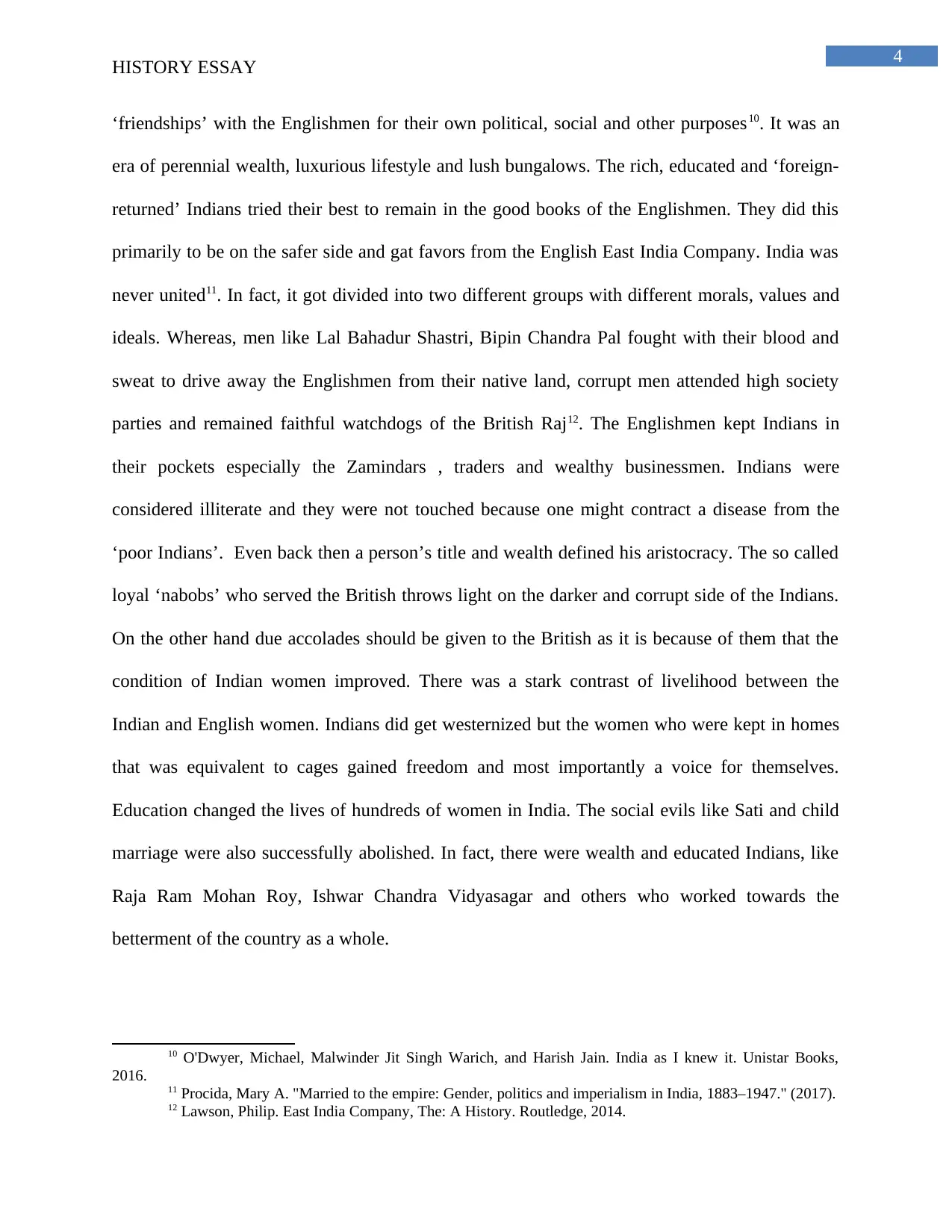
4
HISTORY ESSAY
‘friendships’ with the Englishmen for their own political, social and other purposes10. It was an
era of perennial wealth, luxurious lifestyle and lush bungalows. The rich, educated and ‘foreign-
returned’ Indians tried their best to remain in the good books of the Englishmen. They did this
primarily to be on the safer side and gat favors from the English East India Company. India was
never united11. In fact, it got divided into two different groups with different morals, values and
ideals. Whereas, men like Lal Bahadur Shastri, Bipin Chandra Pal fought with their blood and
sweat to drive away the Englishmen from their native land, corrupt men attended high society
parties and remained faithful watchdogs of the British Raj12. The Englishmen kept Indians in
their pockets especially the Zamindars , traders and wealthy businessmen. Indians were
considered illiterate and they were not touched because one might contract a disease from the
‘poor Indians’. Even back then a person’s title and wealth defined his aristocracy. The so called
loyal ‘nabobs’ who served the British throws light on the darker and corrupt side of the Indians.
On the other hand due accolades should be given to the British as it is because of them that the
condition of Indian women improved. There was a stark contrast of livelihood between the
Indian and English women. Indians did get westernized but the women who were kept in homes
that was equivalent to cages gained freedom and most importantly a voice for themselves.
Education changed the lives of hundreds of women in India. The social evils like Sati and child
marriage were also successfully abolished. In fact, there were wealth and educated Indians, like
Raja Ram Mohan Roy, Ishwar Chandra Vidyasagar and others who worked towards the
betterment of the country as a whole.
10 O'Dwyer, Michael, Malwinder Jit Singh Warich, and Harish Jain. India as I knew it. Unistar Books,
2016. 11 Procida, Mary A. "Married to the empire: Gender, politics and imperialism in India, 1883–1947." (2017).
12 Lawson, Philip. East India Company, The: A History. Routledge, 2014.
HISTORY ESSAY
‘friendships’ with the Englishmen for their own political, social and other purposes10. It was an
era of perennial wealth, luxurious lifestyle and lush bungalows. The rich, educated and ‘foreign-
returned’ Indians tried their best to remain in the good books of the Englishmen. They did this
primarily to be on the safer side and gat favors from the English East India Company. India was
never united11. In fact, it got divided into two different groups with different morals, values and
ideals. Whereas, men like Lal Bahadur Shastri, Bipin Chandra Pal fought with their blood and
sweat to drive away the Englishmen from their native land, corrupt men attended high society
parties and remained faithful watchdogs of the British Raj12. The Englishmen kept Indians in
their pockets especially the Zamindars , traders and wealthy businessmen. Indians were
considered illiterate and they were not touched because one might contract a disease from the
‘poor Indians’. Even back then a person’s title and wealth defined his aristocracy. The so called
loyal ‘nabobs’ who served the British throws light on the darker and corrupt side of the Indians.
On the other hand due accolades should be given to the British as it is because of them that the
condition of Indian women improved. There was a stark contrast of livelihood between the
Indian and English women. Indians did get westernized but the women who were kept in homes
that was equivalent to cages gained freedom and most importantly a voice for themselves.
Education changed the lives of hundreds of women in India. The social evils like Sati and child
marriage were also successfully abolished. In fact, there were wealth and educated Indians, like
Raja Ram Mohan Roy, Ishwar Chandra Vidyasagar and others who worked towards the
betterment of the country as a whole.
10 O'Dwyer, Michael, Malwinder Jit Singh Warich, and Harish Jain. India as I knew it. Unistar Books,
2016. 11 Procida, Mary A. "Married to the empire: Gender, politics and imperialism in India, 1883–1947." (2017).
12 Lawson, Philip. East India Company, The: A History. Routledge, 2014.
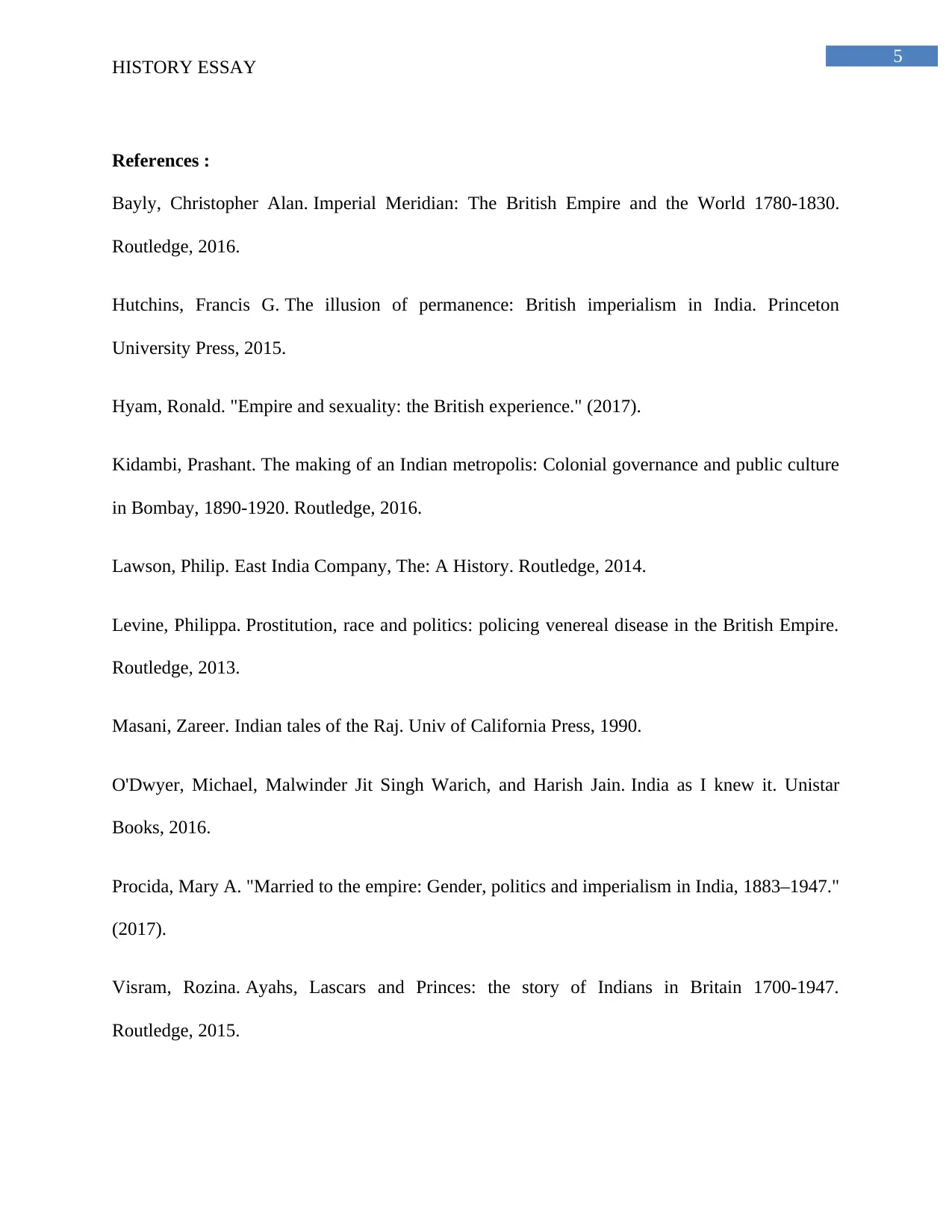
5
HISTORY ESSAY
References :
Bayly, Christopher Alan. Imperial Meridian: The British Empire and the World 1780-1830.
Routledge, 2016.
Hutchins, Francis G. The illusion of permanence: British imperialism in India. Princeton
University Press, 2015.
Hyam, Ronald. "Empire and sexuality: the British experience." (2017).
Kidambi, Prashant. The making of an Indian metropolis: Colonial governance and public culture
in Bombay, 1890-1920. Routledge, 2016.
Lawson, Philip. East India Company, The: A History. Routledge, 2014.
Levine, Philippa. Prostitution, race and politics: policing venereal disease in the British Empire.
Routledge, 2013.
Masani, Zareer. Indian tales of the Raj. Univ of California Press, 1990.
O'Dwyer, Michael, Malwinder Jit Singh Warich, and Harish Jain. India as I knew it. Unistar
Books, 2016.
Procida, Mary A. "Married to the empire: Gender, politics and imperialism in India, 1883–1947."
(2017).
Visram, Rozina. Ayahs, Lascars and Princes: the story of Indians in Britain 1700-1947.
Routledge, 2015.
HISTORY ESSAY
References :
Bayly, Christopher Alan. Imperial Meridian: The British Empire and the World 1780-1830.
Routledge, 2016.
Hutchins, Francis G. The illusion of permanence: British imperialism in India. Princeton
University Press, 2015.
Hyam, Ronald. "Empire and sexuality: the British experience." (2017).
Kidambi, Prashant. The making of an Indian metropolis: Colonial governance and public culture
in Bombay, 1890-1920. Routledge, 2016.
Lawson, Philip. East India Company, The: A History. Routledge, 2014.
Levine, Philippa. Prostitution, race and politics: policing venereal disease in the British Empire.
Routledge, 2013.
Masani, Zareer. Indian tales of the Raj. Univ of California Press, 1990.
O'Dwyer, Michael, Malwinder Jit Singh Warich, and Harish Jain. India as I knew it. Unistar
Books, 2016.
Procida, Mary A. "Married to the empire: Gender, politics and imperialism in India, 1883–1947."
(2017).
Visram, Rozina. Ayahs, Lascars and Princes: the story of Indians in Britain 1700-1947.
Routledge, 2015.
⊘ This is a preview!⊘
Do you want full access?
Subscribe today to unlock all pages.

Trusted by 1+ million students worldwide
1 out of 6
Related Documents
Your All-in-One AI-Powered Toolkit for Academic Success.
+13062052269
info@desklib.com
Available 24*7 on WhatsApp / Email
![[object Object]](/_next/static/media/star-bottom.7253800d.svg)
Unlock your academic potential
Copyright © 2020–2025 A2Z Services. All Rights Reserved. Developed and managed by ZUCOL.





